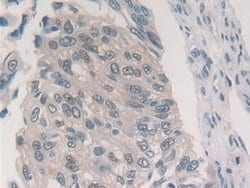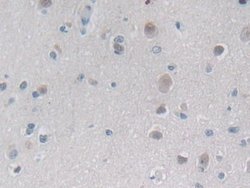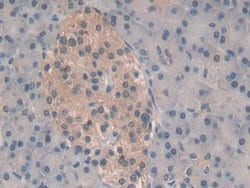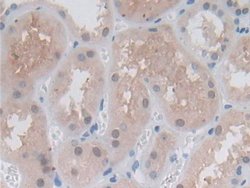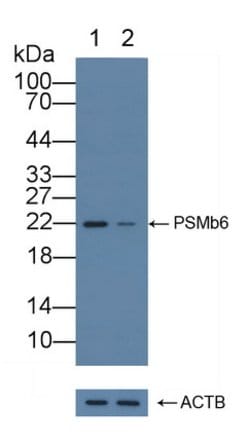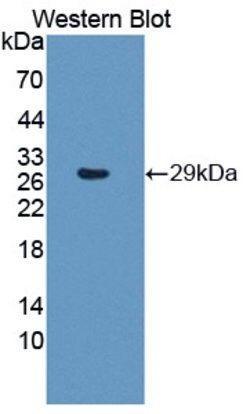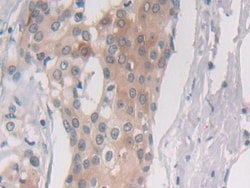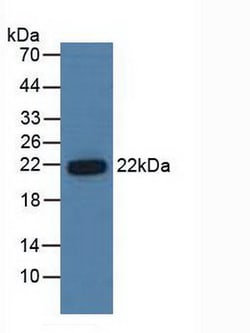Promotional price valid on web orders only. Your contract pricing may differ. Interested in signing up for a dedicated account number?
Learn More
Learn More
Invitrogen™ PSMB6 Polyclonal Antibody
Rabbit Polyclonal Antibody
$209.50 - $511.50
Specifications
| Antigen | PSMB6 |
|---|---|
| Concentration | 0.5 mg/mL |
| Content And Storage | Store at 4°C short term. For long term storage, store at -20°C, avoiding freeze/thaw cycles. |
| Applications | Immunohistochemistry (Paraffin), Western Blot |
| Classification | Polyclonal |
| Catalog Number | Mfr. No. | Quantity | Price | Quantity & Availability | |||||
|---|---|---|---|---|---|---|---|---|---|
| Catalog Number | Mfr. No. | Quantity | Price | Quantity & Availability | |||||
|
PIPA5119367
|
Invitrogen™
PA5119367 |
200 μL |
Each for $511.50
|
|
|||||
|
PIPA5121890
|
Invitrogen™
PA5121890 |
20 μL |
Each for $209.50
|
|
|||||
Description
PSMB6 Polyclonal Antibody for Western Blot, IHC (P)
Proteolytic degradation is critical to the maintenance of appropriate levels of short-lived and regulatory proteins as important and diverse as those involved in cellular metabolism, heat shock and stress response, antigen presentation, modulation of cell surface receptors and ion channels, cell cycle regulation, transcription, and signaling factors. The ubiquitin-proteasome pathway deconstructs most proteins in the eukaryotic cell cytosol and nucleus. Other proteins are degraded via the vacuolar pathway which includes endosomes, lysosomes, and the endoplasmic reticulum. The 26S proteasome is an ATP-dependent, multisubunit (~31), barrel-shaped molecular machine with an apparent molecular weight of ~2.5 MDa. It consists of a 20S proteolytic core complex which is crowned at one or both ends by 19S regulatory subunit complexes. The 19S regulatory subunits recognize ubiquitinated proteins and play an essential role in unfolding and translocating targets into the lumen of the 20S subunit. The PA28/11S REG Activator protein complex functions as a proteolytic activator. This complex, consisting of alpha, beta, and gamma subunits, enhances the activity of the 20S proteolytic core. An enzymatic cascade is responsible for the attachment of multiple ubiquitin molecules to lysine residues of proteins targeted for degradation. Several genetic diseases are associated with defects in the ubiquitin-proteasome pathway. Some examples of affected proteins include those linked to cystic fibrosis (CF transmembrane regulator), Angelmane's syndrome (E6-AP), and Liddle syndrome (endothelial sodium channels).Specifications
| PSMB6 | |
| Store at 4°C short term. For long term storage, store at -20°C, avoiding freeze/thaw cycles. | |
| Polyclonal | |
| Liquid | |
| IgG | |
| Human | |
| PSMB6 | |
| DELTA; Lmp19; LMPY; low molecular mass protein 19; Macropain delta chain; Mpnd; multicatalytic endopeptidase complex delta chain; proteasome (prosome, macropain) subunit, beta type 6; proteasome (prosome, macropain) subunit, beta type, 6; proteasome 20S subunit beta 6; proteasome beta 6 subunit; proteasome catalytic subunit 1; proteasome chain 5; Proteasome delta chain; proteasome subunit beta 6; proteasome subunit beta type-6; proteasome subunit delta; proteasome subunit Y; Psmb6; Psmb6l; PSY large multifunctional protease Y; RP23-122P1.4; subunit 2; Y | |
| PSMB6 | |
| Primary | |
| Antigen affinity chromatography, Protein A |
| 0.5 mg/mL | |
| Immunohistochemistry (Paraffin), Western Blot | |
| Unconjugated | |
| Rabbit | |
| RUO | |
| PBS with 50% glycerol and 0.05% ProClin 300; pH 7.4 | |
| P28072 | |
| 5694 | |
| Recombinant protein Proteasome Subunit Beta Type 6. The antigen corresponds to amino acid range 2-239 of the target protein. | |
| Antibody |
Spot an opportunity for improvement?Share a Content Correction
Product Content Correction
Your input is important to us. Please complete this form to provide feedback related to the content on this product.
Product Title
